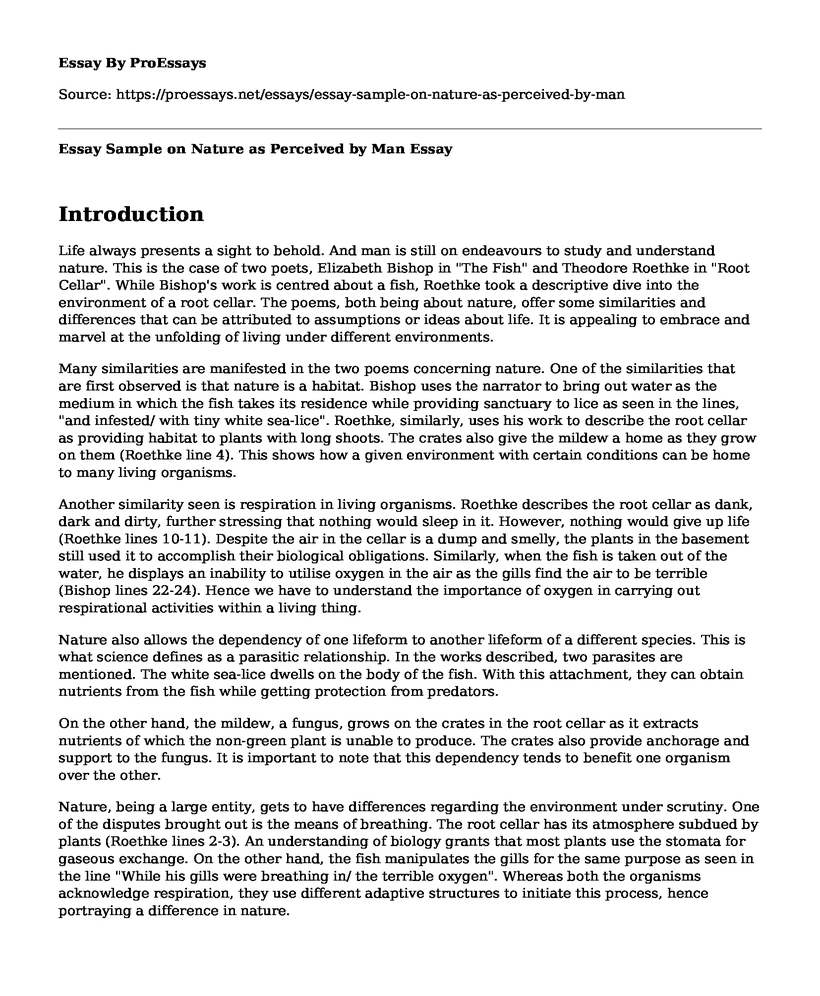Introduction
Life always presents a sight to behold. And man is still on endeavours to study and understand nature. This is the case of two poets, Elizabeth Bishop in "The Fish" and Theodore Roethke in "Root Cellar". While Bishop's work is centred about a fish, Roethke took a descriptive dive into the environment of a root cellar. The poems, both being about nature, offer some similarities and differences that can be attributed to assumptions or ideas about life. It is appealing to embrace and marvel at the unfolding of living under different environments.
Many similarities are manifested in the two poems concerning nature. One of the similarities that are first observed is that nature is a habitat. Bishop uses the narrator to bring out water as the medium in which the fish takes its residence while providing sanctuary to lice as seen in the lines, "and infested/ with tiny white sea-lice". Roethke, similarly, uses his work to describe the root cellar as providing habitat to plants with long shoots. The crates also give the mildew a home as they grow on them (Roethke line 4). This shows how a given environment with certain conditions can be home to many living organisms.
Another similarity seen is respiration in living organisms. Roethke describes the root cellar as dank, dark and dirty, further stressing that nothing would sleep in it. However, nothing would give up life (Roethke lines 10-11). Despite the air in the cellar is a dump and smelly, the plants in the basement still used it to accomplish their biological obligations. Similarly, when the fish is taken out of the water, he displays an inability to utilise oxygen in the air as the gills find the air to be terrible (Bishop lines 22-24). Hence we have to understand the importance of oxygen in carrying out respirational activities within a living thing.
Nature also allows the dependency of one lifeform to another lifeform of a different species. This is what science defines as a parasitic relationship. In the works described, two parasites are mentioned. The white sea-lice dwells on the body of the fish. With this attachment, they can obtain nutrients from the fish while getting protection from predators.
On the other hand, the mildew, a fungus, grows on the crates in the root cellar as it extracts nutrients of which the non-green plant is unable to produce. The crates also provide anchorage and support to the fungus. It is important to note that this dependency tends to benefit one organism over the other.
Nature, being a large entity, gets to have differences regarding the environment under scrutiny. One of the disputes brought out is the means of breathing. The root cellar has its atmosphere subdued by plants (Roethke lines 2-3). An understanding of biology grants that most plants use the stomata for gaseous exchange. On the other hand, the fish manipulates the gills for the same purpose as seen in the line "While his gills were breathing in/ the terrible oxygen". Whereas both the organisms acknowledge respiration, they use different adaptive structures to initiate this process, hence portraying a difference in nature.
Additionally, there is a difference in the mode of feeding of an organism. Ideally, plants manufacture their food. Therefore, scientifically speaking, the plants in the root cellar can manufacture their nutrients. This is the concept of autotrophic nutrition. However, having yellow shoots can be related to the cellar having low light intensity, making the plants to strain to achieve photosynthesis.
Meanwhile, when the mildew and white sea-lice rely on the crates and the fish for nutrients respectively, parasitic nutrition is explained. The fish expresses what is known as heterotrophic nutrition. This illustrates the different ways of obtaining nutrients by living organisms to necessitate life and survival.
Another difference portrayed is in the adaptive nature of living things to their environment. Plants in the root cellar developed long shoots to compete for the limited light and air. The bulbs implemented a phototaxy response while looking for light as seen in the second line of the poem by Roethke. The fish also flaunts adaptations in the gills for breathing (Bishop). Moreover, the presence of a swim-bladder aids the fish in achieving vertical motion in the water. He has irises with a coating that resembles a tarnished tinfoil to protect the eyes while under water. Metaphorically, the difference in the adaptive structures of the organisms can be used to pass a message. It is a teaching on contentment. Adapting to one's situation is better than searching for the perfect environment.
Conclusion
In summary, the beauty of nature is a profound spectacle. While embracing the eminence, one should also consider how nature is shaping itself to accommodate everyone. Understanding the similarities and differences shown in nature is the key to developing better ways of conserving the environment while taking into consideration the ecosystems of the said environment. Every lifeform experiences life differently.
Work Cited
Bishop, Elizabeth. The Fish. 1946.
Roethke, Theodore. "Root Cellar." The Lost Son and Other Poems. New York: Doubleday and Company, 1948.
Cite this page
Essay Sample on Nature as Perceived by Man. (2022, Oct 28). Retrieved from https://proessays.net/essays/essay-sample-on-nature-as-perceived-by-man
If you are the original author of this essay and no longer wish to have it published on the ProEssays website, please click below to request its removal:
- Why Orca Whales Should Not Live in Captivity Essay
- Anatomy Essay Example on Human Muscles
- Carbon Tax Versus Cap-and-Trade - Paper Example
- Our Moral Obligation to Future Generations in Reigning in Global Warming and its Negative Effects
- Essay on Gas Incident in Bhopal: An Accident With Deadly Consequences
- Essay Example on Wind Turbines: Safe Renewable Energy for Climate and Human Health
- Air Pollution: A Crisis More Deadly Than Any Pandemic - Essay Sample







